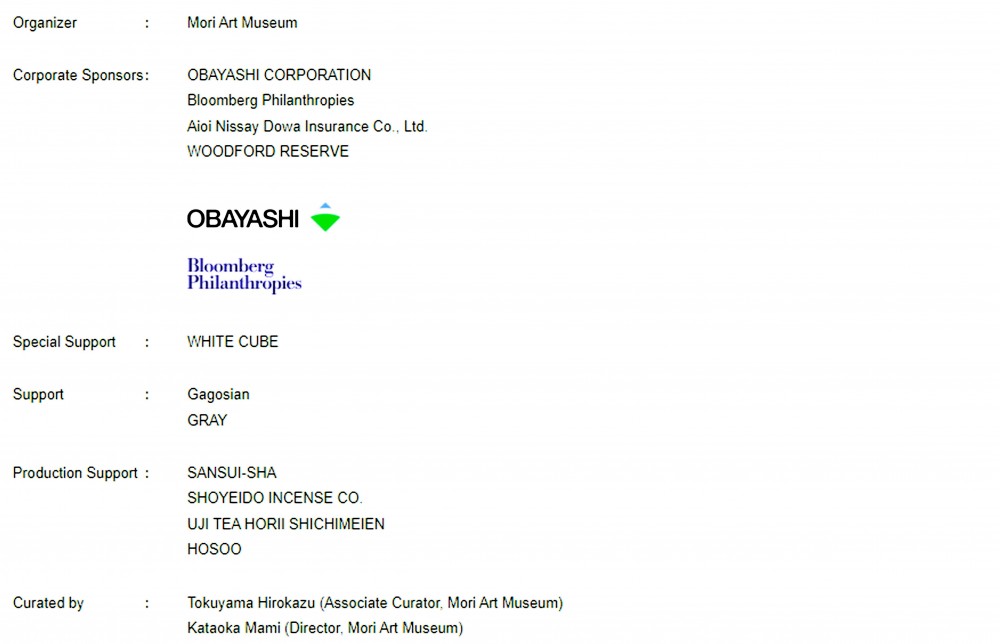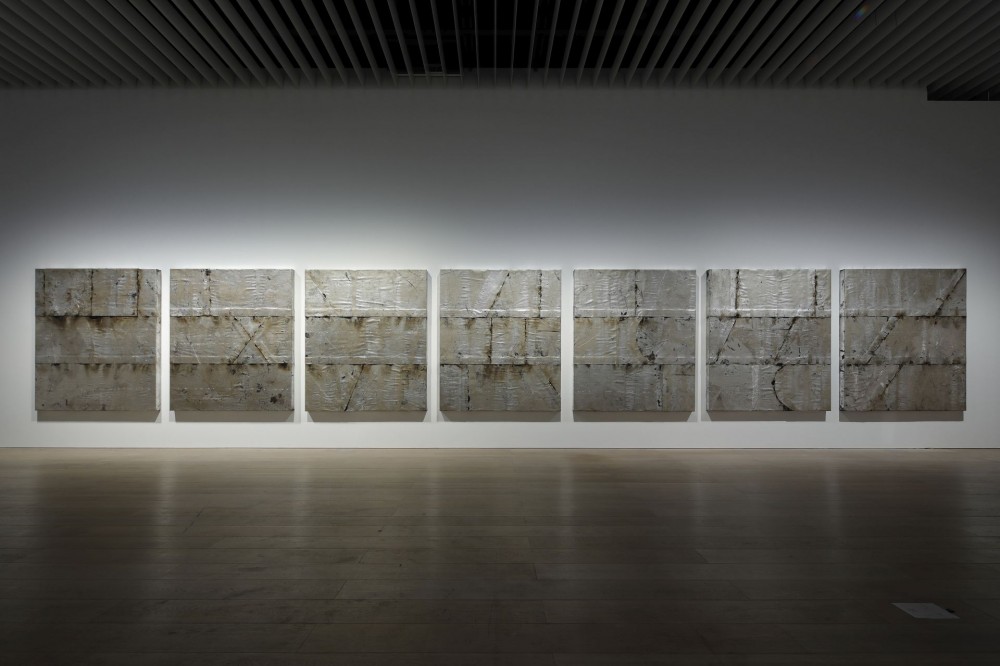
Theaster Gates
Seven Songs
2022
Industrial oil-based enamel, rubber torch down, bitumen, and wood
217 x 187 x 13cm (each, set of 7)
Installation view: Theaster Gates: Afro-Mingei, Mori Art Museum, Tokyo, 2024
Photo: Koroda Takeru
Photo courtesy: Mori Art Museum, Tokyo
The Mori Art Museum, Tokyo, is proud to present the exhibition titled Theaster Gates: Afro-Mingei from Wednesday, April 24, to Sunday, September 1, 2024.
Based on the South Side of Chicago, IL, Theaster Gates (b. 1973 in Chicago) has earned international acclaim for a practice that traverses multiple media and genres, primarily focusing on sculpture and ceramics but also encompassing architecture, music, performance, fashion and design. Trained as a sculptor and urban planner, Gates has been influenced by Japanese craft and culture over the past 20 years. He first traveled to in 2004 Japan to study ceramics in Tokoname, Aichi Prefecture. His deep encounters in Japan and across the Asia-Pacific, coupled with his experiences as an African-American man with roots in Mississippi and Chicago have been the keystones of his creative process. Gates, who has explored cultural hybridity over the course of his practice, coined the term “Afro-Mingei,” his unique conceptual framework fusing the philosophies of the Japanese Mingei Movement and the aesthetics of the “Black Is Beautiful” cultural movement that played a significant part in the American Civil Rights Movement (1954-1968). Theaster Gates: Afro-Mingei is Gates’ first solo exhibition in Japan and largest-ever in Asia, with the speculative proposition of “Afro-Mingei” placed as the central backbone of the presentation. This exhibition showcases major bodies of existing and never-before-seen work that demonstrate the influence of Japanese culture on his practice.
As the world reexamines the historical and contemporary prominence of certain voices and seeks to diversify the perspectives represented, the global art scene has been increasingly interested in the multiplicity of experiences reflected in the work of leading Black artists. While Black histories remain relatively little known among the Japanese public, this exhibition demonstrates its growing attention to Black art through the multidimensional practice of Theaster Gates. Afro-Mingei will convey the importance of contemporary art that honors craft, ask us to consider questions of race and politics, and celebrate the hybrid possibilities of culture.
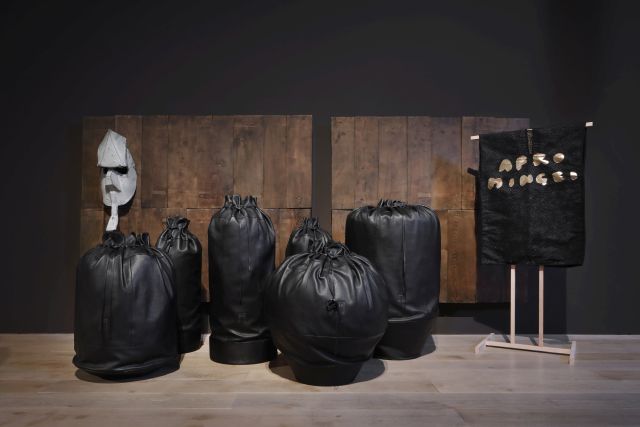
Installation view: Theaster Gates: Afro-Mingei, Mori Art Museum, Tokyo, 2024
Photo: Koroda Takeru
Photo courtesy: Mori Art Museum, Tokyo
MESSAGE FROM THE ARTIST, THEASTER GATES
For more than 20 years, the Mingei Movement has been an important guidepost for me in understanding the mechanics of celebration associated with the beauty that a people make. The Mingei Movement, like the Black Power Movement of the United States, was attempting to preserve and honor a very specific past as the west quickly encroached. While both had blind spots, biases and detractors, their resolve was to celebrate the local, raise awareness of beauty and honor the power of culture. Afro-Mingei is an attempt to marry the most significant movements of my artistic journey.
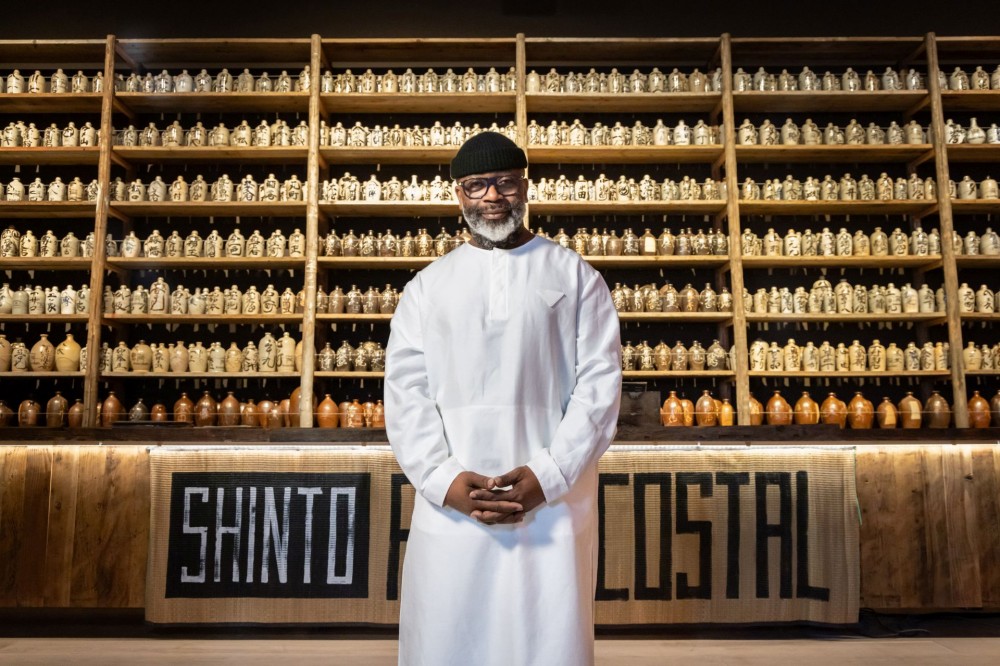
Photo: Tayama Tatsuyuki
Photo courtesy: Mori Art Museum, Tokyo
BIOGRAPHY
Born 1973 in Chicago, IL, where he continues to live, Theaster Gates studied urban design, ceramics, religion, and visual art at Iowa State University and the University of Cape Town, South Africa. He masterfully translates the intricacies of Blackness through clay, objecthood, music, film, space and materiality. In 2004, Gates began his now twenty-year engagement with the ceramic legacies of the city of Tokoname in Aichi Prefecture, Japan, where he participated in the International Workshop of Ceramic Art in Tokoname [IWCAT] pottery homestay program and continues to honor and artistically invest in local makers and craft histories. In recent years, he has had major solo exhibitions at such institutions as the New Museum (New York, 2022–23), Serpentine Pavilion (London, 2022), Whitechapel Gallery (London, 2021), Walker Art Center (Minneapolis, 2019–20), Martin Gropius Bau (Berlin, 2019), Palais de Tokyo (Paris, 2019), and Fondazione Prada (Milan, 2018). In Japan, Gates exhibited at the Aichi Triennale 2022, and in 2019 was selected for the Obayashi Foundation Research Program, “Visions of the City.”
EXHIBITION FEATURES AND HIGHLIGHTS
Largest-ever solo exhibition in Japan by a Black artist
Theaster Gates: Afro-Mingei offers the priceless opportunity to experience major past works and never-seen-before new works created for this exhibition from a prominent practitioner of Black art, a domain that has been attracting growing interest from the international art world in recent years. The all-embracing content, including an introduction to the Black histories and cultures that underpin Gates’ practice, makes it the largest-ever exhibition of its kind to be staged in Japan. Featured is a substantial body of work, including a large-scale installation utilizing ceramics made in Tokoname and Gates’ own ceramic sculptures, collections of historical archival materials, tar paintings, sound installations, and video works.
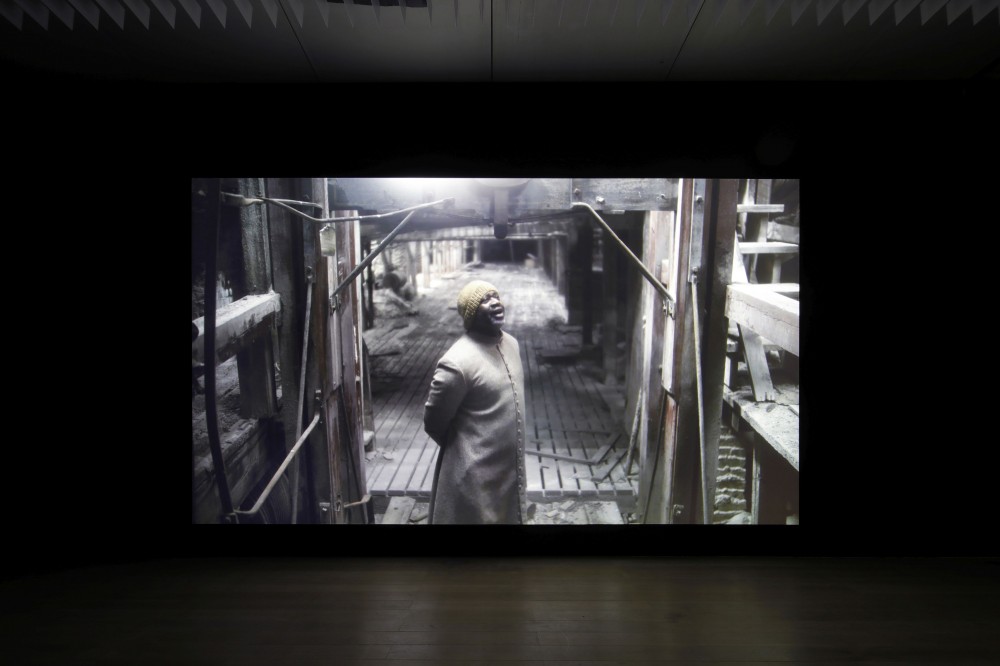
Theaster Gates
Oh, the Wind
2024
High-definition video
11 min. 57 sec.
Installation view: Theaster Gates: Afro-Mingei, Mori Art Museum, Tokyo, 2024
Photo: Koroda Takeru
Photo courtesy: Mori Art Museum, Tokyo
Showcases Black history’s influence on contemporary culture, from the “Black Is Beautiful” Movement to speculative futures envisaged by Gates
The Black craft practices, art, music, and fashion that have played major roles in past resistance to anti-Black discrimination and oppression including Black Lives Matter (BLM), now have a higher profile than ever before, thanks in part to Gates’ artistic interventions elevating histories of the past that others had written off. It indeed reflects a culture that has actively and creatively resisted centuries of racial violence and colonial exploitation. In Theaster Gates: Afro-Mingei, Gates’ multidisciplinary oeuvre will demonstrate the importance and emergence of Black culture today.
Presents Gates’ representative projects of spatial practices including architectural projects centered in Chicago
Theaster Gates: Afro-Mingei employs archival materials to introduce Gates’ world-renowned architectural interventions through one of his best-known projects: the Rebuild Foundation (2009-). Undertaken on Chicago’s South Side, a predominantly Black community that was intentionally isolated and denied equal right to property and city-wide investment, Gates, through Rebuild Foundation, has rescued over 40 buildings from abandonment, transforming them into spaces of public engagement with art and culture. The Foundation’s work includes archiving and presenting important collections of objects that chronicle Black history and culture. For example, Gates stewards and invites the community to witness and participate in the preservation of culturally and historically valuable objects from the archives of the Chicago-based Johnson Publishing Company (JPC), publishers of the widely circulated periodicals in the second half of the 20th century on Black life, Ebony and Jet magazines, and the personal collection of records of the late “Godfather of House Music” Frankie Knuckles (1955-2014), just to name a few.
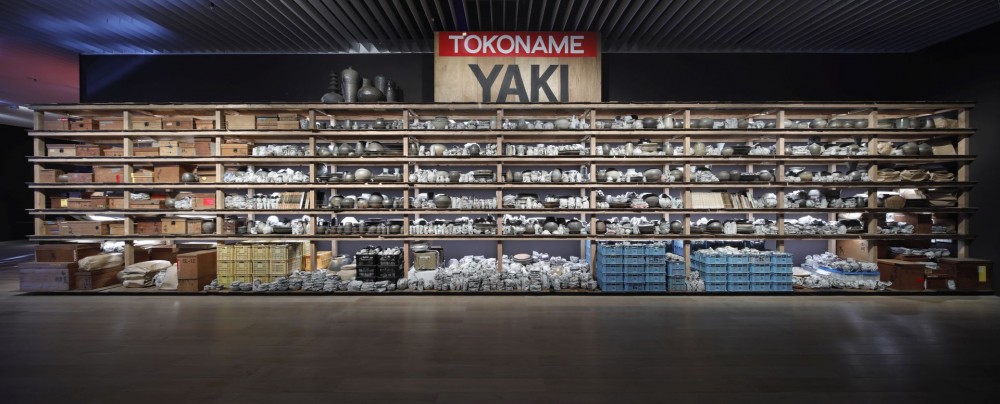
The Koide Yoshihiro Collection (1941-2022), and others
Installation view: Theaster Gates: Afro-Mingei, Mori Art Museum, Tokyo, 2024
Photo: Koroda Takeru
Photo courtesy: Mori Art Museum, Tokyo
New works and projects with a Japanese connection
Theaster Gates: Afro-Mingei features works that imagine, amalgamate and hybridize Black and Japanese historical and cultural elements, including ceramics made in Tokoname, sculptural interventions inspired by Chicago funk music and lounges, a sound installation featuring a church organ, works by late Edo-period poet and ceramic artist Otagaki Rengetsu and new bodies of work anchored by Japanese incense, sake and tea rituals.
“Black Library” book lounge right in the gallery
An interactive and participatory library with shelves filling the gallery walls has been created for the exhibition, offering visitors the chance to browse a few thousand publications on Black art, history and culture.
Full program of events including music and workshops
A diverse program of events designed to showcase the breadth of Gates’ practice is planned for the duration of the exhibition including sonic and olfactory activations and an off-site installation at the former Earthenware Pipe Factory (Maruri-Toukan) in the city of Tokoname.
WHAT IS “AFRO-MINGEI”?
“Afro-Mingei” is the manifestation of a new creative ideology wherein Theaster Gates imagines the artistic possibilities of combining Black aesthetics and Japanese craft philosophies to envision hybrid-culture futures. It traces his long-established and enduring relationship with Japanese, Chinese and Korean ceramic histories, conceiving of an artistic and intellectual invitation that considers Black political movements alongside Japanese craft resistance. In addition, “Afro-Mingei” also is a reflection on two very important movements - the “ Black Is Beautiful ” Movement of the United States and the Mingei Movement of Japan – both of which used public spectacle, academic debate, and propaganda as tools of self-empowerment when cultural independence was under threat by external and dominant forces of Modernity and Western assimilation. For Gates, “Afro-Mingei” is a fiction yet a deep truth. As the culmination of this project to date, staging a show in the country that gave birth to the Mingei movement so influential in Gates’ art is an homage and testament to the ways that culture proliferates in a country, in the world, and between cultures.
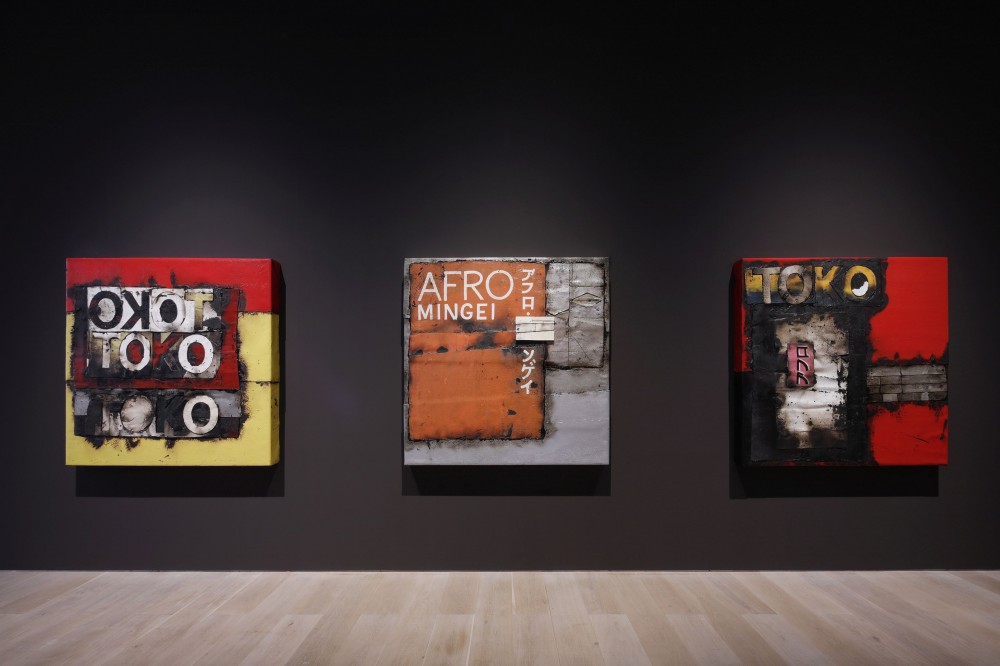
Installation view: Theaster Gates: Afro-Mingei, Mori Art Museum, Tokyo, 2024
Photo: Koroda Takeru
Photo courtesy: Mori Art Museum, Tokyo
KEYS TO UNDERSTANDING “AFRO-MINGEI”
1. What is “Afro”?
The prefix Afro- that more broadly means “African” (as in Afro-Americans, for example), refers to the hairstyle that gained popularity as a symbol of Black identity and empowerment during the years of the Civil Rights Movement in the US.
2. Nameless craftsmen and neglected materials in Mingei
The term Mingei was coined by religious philosopher and art critic Yanagi Soetsu a.k.a. Yanagi Muneyoshi (1889-1961) alongside like-minded associates such as potters Hamada Shoji and Kawai Kanjiro, and refers to folk crafts produced by nameless artisans. Yanagi saw Mingei, born out of the tapestry of art, philosophy and religion that comprises traditional Japanese culture, as harboring “a singular beauty absent from conventional notions of art and aesthetics.” Mingei finds true beauty not in the output of individual artists, but in works created in artisans ’ innocence, or items used by people as part of their day-to-day routines.
3. Hybridity of “Afro” and “Mingei”
Gates’ works in the exhibition translate ideologies of Blackness that emerged out of a collective consciousness developed by African-Americans in resistance to, and as survival from the preexisting, often oppressive, American consciousness. Utilizing his predisposition to what can be called a ‘double consciousness,’* Gates allows these objects to thrive in new cultural contexts where experimental binaries can be reimagined through “Afro-Mingei.” Audaciously combining African craftworks and symbols of a deeply-layered Black American consciousness such as the Hammond B-3 organ - which is an allegory for the spiritual and political refuge sought by the Black community during times of racial tension and often used in Pentecostal and Baptist churches - with Japanese ceramics and ritual objects such as tea, incense and sake wares, Gates attempts to honor these generational crafts and create new cultural value.
* The idea of ‘double consciousness’ was first introduced by W. E. B. Du Bois (1868-1963), an African-American intellect and civil rights activist in his book The Souls of Black Folk (1903).
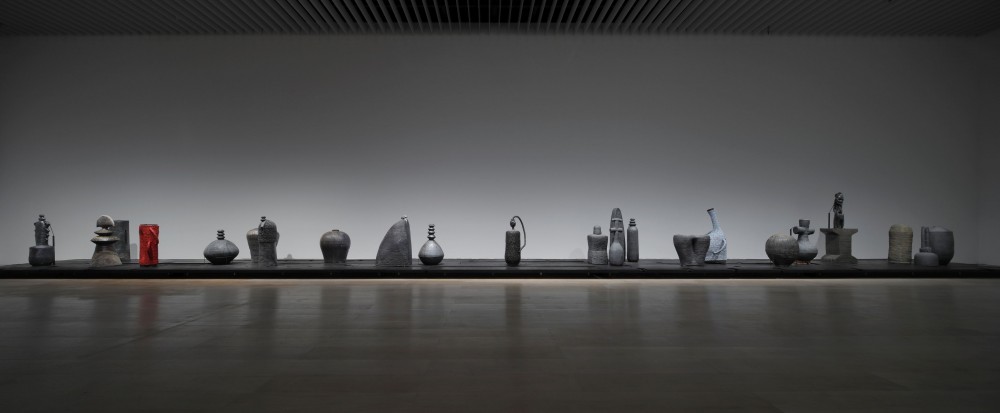
Theaster Gates
Black Vessels for Doric Temple (2022-2023), and others
Installation view: Theaster Gates: Afro-Mingei, Mori Art Museum, Tokyo, 2024
Photo: Koroda Takeru
Photo courtesy: Mori Art Museum, Tokyo
4. Multiple origins seen in his ceramic works
Over the years, Gates has presented ceramic works from multiple perspectives. An important early project concerned “Yamaguchi Shoji,” a fictional ceramicist who traveled from Japan to the US state of Mississippi. The pieces by Yamaguchi, who married a Black woman and melded Japanese pottery and African-American expression, were all creations of Gates himself. His other works of ceramic art show the influence of the enslaved potter David Drake (c.1800-1870s), American ceramic artist Peter Voulkos (1924-2002), and the diverse history of Japanese ceramic art. Often products of this hybrid background, Gates’ pottery pieces offer a vital medium for the interpretation of “Afro-Mingei.”
5. Collaboration and community
Gates’ community revitalization projects on Chicago’s South Side are meant to revive old buildings as a demonstration that there is life within forgotten spaces and to create new hubs where people can meet, mingle and collaborate. Yanagi stated that in Mingei, “one may witness a world of true cooperation,” and also wrote that in most cases, this did not come about without the help of local people, and that “one cannot expect proper craft from a social structure in chaos.”* Gates’ projects, which could also be described as social contribution through creativity, echo and resonate with this idea.
* Yanagi, Soetsu. Kogei no michi [The Way of Craft] (Tokyo: Kodansha Gakujutsu Bunko, 2005), pp. 54-55.
